Fusarium Mycotoxins Zearalenone and Deoxynivalenol Reduce Hepatocyte Innate Immune Response after the Listeria monocytogenes Infection by Inhibiting the TLR2/NFκB Signaling Pathway
Abstract
:1. Introduction
2. Results
2.1. ZEA and DON Can Inhibit the Viability of BRL 3A Cells
2.2. ZEA and DON Inhibited Gene and Protein Expression of TLR2 and MyD88 in All BRL 3A Cells
2.3. ZEA and DON Inhibit LTA-Induced BRL 3A Cells NOS2 Expression and NO Production
2.4. ZEA and DON Inhibited the Activation of the TRL2/NFκB Signaling Pathway in BRL 3A Cells Induced by LTA
2.5. Effects of ZEA and DON on Liver Histological Parameters and Bacterial Loads in L. monocytogenes-Infected Mice
2.6. ZEA and DON Inhibited the Expression Level of NOS2 and NO Production in the Liver of L. monocytogenes-Infected Mice
2.7. ZEA and DON Inhibited the TLR2/NFκB Signaling Pathway in the Liver of L. monocytogenes-Infected Mice
3. Discussion
4. Materials and Methods
4.1. Chemicals and Reagent
4.2. Cell Cultures
4.3. Cell Proliferation Assay
4.4. Bacterial Cultures
4.5. Animal and Experiment Design
4.6. Liver Pathological Analysis
4.7. Bacterial Load Detection
4.8. NO Level Detection
4.9. Western Blot Detection of Related Protein Expression
4.10. Quantitative RT-PCR Detection of Related mRNA Expression
4.11. Immunofluorescence Analysis
4.12. Statistical Analyses
5. Conclusions
Author Contributions
Funding
Institutional Review Board Statement
Data Availability Statement
Acknowledgments
Conflicts of Interest
References
- Ropejko, K.; Twarużek, M. Zearalenone and Its Metabolites-General Overview, Occurrence, and Toxicity. Toxins 2021, 13, 35. [Google Scholar] [CrossRef] [PubMed]
- Bai, Y.; Ma, K.; Li, J.; Li, J.; Bi, C.; Shan, A. Deoxynivalenol exposure induces liver damage in mice: Inflammation and immune responses, oxidative stress, and protective effects of Lactobacillus rhamnosus GG. Food Chem. Toxicol. 2021, 156, 112514. [Google Scholar] [CrossRef] [PubMed]
- Liu, M.; Zhao, L.; Gong, G.; Zhang, L.; Shi, L.; Dai, J.; Han, Y.; Wu, Y.; Khalil, M.M.; Sun, L. Invited review: Remediation strategies for mycotoxin control in feed. J. Anim. Sci. Biotechnol. 2022, 13, 19. [Google Scholar] [CrossRef] [PubMed]
- Zhao, F.; Li, R.; Xiao, S.; Diao, H.; Viveiros, M.M.; Song, X.; Ye, X. Postweaning Exposure to Dietary Zearalenone, a Mycotoxin, Promotes Premature Onset of Puberty and Disrupts Early Pregnancy Events in Female Mice. Toxicol. Sci. 2013, 132, 431–442. [Google Scholar] [CrossRef]
- Bracarense, A.; Lucioli, J.; Grenier, B.; Pacheco, G.D.; Moll, W.D.; Schatzmayr, G.; Oswald, I.P. Chronic ingestion of deoxynivalenol and fumonisin, alone or in interaction, induces morphological and immunological changes in the intestine of piglets. Br. J. Nutr. 2012, 107, 1776–1786. [Google Scholar] [CrossRef] [Green Version]
- Cai, G.; Pan, S.; Feng, N.; Zou, H.; Gu, J.; Yuan, Y.; Liu, X.; Liu, Z.; Bian, J. Zearalenone inhibits T cell chemotaxis by inhibiting cell adhesion and migration related proteins. Ecotoxicol. Environ. Saf. 2019, 175, 263–271. [Google Scholar] [CrossRef]
- Gcab, C.; Kai, S.; Sxa, B.; Zfa, B.; Hui, Z.; Jga, B.; Yan, Y.; Jqza, B.; Zlab, C.; Jbab, C. Decrease in immune function and the role of mitogen-activated protein kinase (MAPK) overactivation in apoptosis during T lymphocytes activation induced by zearalenone, deoxynivalenol, and their combinations—ScienceDirect. Chemosphere 2020, 255, 126999. [Google Scholar] [CrossRef]
- Cai, G.; Zhong, F.; Cao, Q.; Bai, Y.; Zou, H.; Gu, J.; Yuan, Y.; Zhu, G.; Liu, Z.; Bian, J. ZEA and DON inhibited inflammation after L. monocytogenes infection and induced ribosomal hyperfunction. Ecotoxicol. Environ. Saf. 2022, 236, 113470. [Google Scholar] [CrossRef]
- Boockvar, K.S.; Granger, D.L.; Poston, R.M.; Maybodi, M.; Washington, M.K.; Hibbs, J.B., Jr.; Kurlander, R.L. Nitric oxide produced during murine listeriosis is protective. Infect. Immun. 1994, 62, 1089–1100. [Google Scholar] [CrossRef] [Green Version]
- Radoshevich, L.; Cossart, P. Listeria monocytogenes: Towards a complete picture of its physiology and pathogenesis. Nat. Rev. Microbiol. 2018, 16, 32–46. [Google Scholar] [CrossRef]
- Poulsen, K.P.; Czuprynski, C.J. Pathogenesis of listeriosis during pregnancy. Anim. Health Res. Rev. 2013, 14, 30–39. [Google Scholar] [CrossRef]
- Schlech, W.F. Epidemiology and Clinical Manifestations of Listeria monocytogenes Infection. Microbiol. Spectr. 2019, 7, 3. [Google Scholar] [CrossRef]
- Posfay-Barbe, K.M.; Wald, E.R. Listeriosis. Semin. Fetal Neonatal Med. 2009, 14, 228–233. [Google Scholar] [CrossRef]
- Vázquez-Boland, J.A.; Kuhn, M.; Berche, P.; Chakraborty, T.; Domínguez-Bernal, G.; Goebel, W.; González-Zorn, B.; Wehland, J.; Kreft, J. Listeria pathogenesis and molecular virulence determinants. Clin. Microbiol. Rev. 2001, 14, 584–640. [Google Scholar] [CrossRef] [Green Version]
- Gaillard, J.L. The inlAB locus mediates the entry of Listeria monocytogenes into hepatocytes in vivo. J. Exp. Med. 1996, 183, 359–369. [Google Scholar] [CrossRef] [PubMed]
- Shen, Y.; Naujokas, M.; Park, M.; Ireton, K. InIB-dependent internalization of Listeria is mediated by the Met receptor tyrosine kinase. Cell 2000, 103, 501–510. [Google Scholar] [CrossRef] [PubMed] [Green Version]
- Fang, F.C. Perspectives series: Host/pathogen interactions. Mechanisms of nitric oxide-related antimicrobial activity. J. Clin. Investig. 1997, 99, 2818–2825. [Google Scholar] [CrossRef] [PubMed] [Green Version]
- Woodmansee, A.N.; Imlay, J.A. A mechanism by which nitric oxide accelerates the rate of oxidative DNA damage in Escherichia coli. Mol. Microbiol. 2003, 49, 11–22. [Google Scholar] [CrossRef]
- Wang, M.; Wang, L.; Fang, L.; Li, S.; Liu, R. NLRC5 negatively regulates LTA-induced inflammation via TLR2/NF-κB and participates in TLR2-mediated allergic airway inflammation. J. Cell. Physiol. 2019, 234, 19990–20001. [Google Scholar] [CrossRef]
- Torres, D.; Barrier, M.; Bihl, F.; Quesniaux, V.; Maillet, I.; Akira, S.; Ryffel, B.; Erard, F. Toll-Like Receptor 2 Is Required for Optimal Control of Listeria monocytogenes Infection. Infect. Immun. 2004, 72, 2131–2139. [Google Scholar] [CrossRef] [PubMed] [Green Version]
- Lavon, I.; Goldberg, I.; Amit, S.; Landsman, L.; Jung, S.; Tsuberi, B.-Z.; Barshack, I.; Kopolovic, J.; Galun, E.; Bujard, H.; et al. High susceptibility to bacterial infection, but no liver dysfunction, in mice compromised for hepatocyte NF-κB activation. Nat. Med. 2000, 6, 573–577. [Google Scholar] [CrossRef] [PubMed]
- Zhao, L.; Liu, M.; Sun, H.; Yang, J.C.; Huang, Y.X.; Huang, J.Q.; Lei, X.; Sun, L.H. Selenium deficiency-induced multiple tissue damage with dysregulation of immune and redox homeostasis in broiler chicks under heat stress. Sci. China Life Sci. 2023. [Google Scholar] [CrossRef] [PubMed]
- Klarić, M.S.; Cvetnić, Z.; Pepeljnjak, S.; Kosalec, I. Co-occurrence of aflatoxins, ochratoxin A, fumonisins, and zearalenone in cereals and feed, determined by competitive direct enzyme-linked immunosorbent assay and thin-layer chromatography. Arh. Za Hig. Rada I Toksikol. 2009, 60, 427–434. [Google Scholar] [CrossRef] [PubMed] [Green Version]
- Ficheux, A.S.; Sibiril, Y.; Parent-Massin, D. Co-exposure of Fusarium mycotoxins: Invitro myelotoxicity assessment on human hematopoietic progenitors. Toxicon Off. J. Int. Soc. Toxinology 2012, 211, S35. [Google Scholar] [CrossRef]
- Gao, X.; Xiao, Z.H.; Liu, M.; Zhang, N.Y.; Khalil, M.M.; Gu, C.Q.; Qi, D.S.; Sun, L.H. Dietary Silymarin Supplementation Alleviates Zearalenone-Induced Hepatotoxicity and Reproductive Toxicity in Rats. J. Nutr. 2018, 148, 1209–1216. [Google Scholar] [CrossRef] [Green Version]
- Liu, M.; Zhang, L.; Mo, Y.; Li, J.; Yang, J.; Wang, J.; Karrow, N.A.; Wu, H.; Sun, L. Ferroptosis is involved in deoxynivalenol-induced intestinal damage in pigs. J. Anim. Sci. Biotechnol. 2023, 14, 29. [Google Scholar] [CrossRef]
- Cai, G.; Liu, S.; Zhong, F.; Gu, J.; Yuan, Y.; Zhu, J.; Zhu, G.; Liu, Z.; Zou, H.; Bian, J. Zearalenone and deoxynivalenol inhibited IL-4 receptor-mediated Th2 cell differentiation and aggravated bacterial infection in mice. Toxicol. Appl. Pharmacol. 2021, 415, 115441. [Google Scholar] [CrossRef]
- Huang, B.; Zhao, J.; Unkeless, J.C.; Feng, Z.H.; Xiong, H. TLR signaling by tumor and immune cells: A double-edged sword. Oncogene 2008, 27, 218–224. [Google Scholar] [CrossRef] [Green Version]
- Takeda, K.; Akira, S. TLR signaling pathways. Semin. Immunol. 2004, 16, 3–9. [Google Scholar] [CrossRef]
- Macmicking, J.D.; Nathan, C.; Hom, G.; Chartrain, N.; Fletcher, D.S.; Trumbauer, M.; Stevens, K.; Xie, Q.W.; Sokol, K.; Hutchinson, N. Altered responses to bacterial infection and endotoxic shock in mice lacking inducible nitric oxide synthase. Cell 1995, 81, 641–650. [Google Scholar] [CrossRef] [Green Version]
- Shiloh, M.U.; Macmicking, J.D.; Nicholson, S.; Brause, J.E.; Nathan, C. Phenotype of mice and macrophages deficient in both phagocyte oxidase and inducible nitric oxide synthase. Immunity 1999, 10, 29–38. [Google Scholar] [CrossRef] [Green Version]
- Adams, L.B.; Job, C.K.; Krahenbuhl, J.L. Role of inducible nitric oxide synthase in resistance to Mycobacterium leprae in mice. Infect. Immun. 2000, 68, 5462–5465. [Google Scholar] [CrossRef] [PubMed] [Green Version]
- Bian, Z.; Yan, Z.-Q.; Hansson, G.K.; Thorén, P.; Normark, S. Activation of Inducible Nitric Oxide Synthase/Nitric Oxide by Curli Fibers Leads to a Fall in Blood Pressure during Systemic Escherichia coli Infection in Mice. J. Infect. Dis. 2001, 183, 612–619. [Google Scholar] [CrossRef] [PubMed] [Green Version]
- Granger, D.L.; Hibbs, J.B.; Perfect, J.R.; Durack, D.T. Specific amino acid (L-arginine) requirement for the microbiostatic activity of murine macrophages. J. Clin. Investig. 1988, 81, 1129–1136. [Google Scholar] [CrossRef] [PubMed] [Green Version]
- Denis, M. Interferon-gamma-treated murine macrophages inhibit growth of tubercle bacilli via the generation of reactive nitrogen intermediates. Cell. Immunol. 1991, 132, 150–157. [Google Scholar] [CrossRef]
- Saxena, S.K.; Mathur, A.; Srivastava, R.C. Induction of nitric oxide synthase during Japanese encephalitis virus infection: Evidence of protective role. Arch. Biochem. Biophys. 2001, 391, 1–7. [Google Scholar] [CrossRef]
- Kröncke, K.D.; Fehsel, K.; Kolb-Bachofen, V. Inducible nitric oxide synthase and its product nitric oxide, a small molecule with complex biological activities. Biol. Chem. Hoppe-Seyler 1995, 376, 327–343. [Google Scholar] [CrossRef]
- Akira, S.; Takeda, K.; Kaisho, T. Toll-like receptors: Critical proteins linking innate and acquired immunity. Nat. Immunol. 2001, 2, 675–680. [Google Scholar] [CrossRef]
- Schwabe, R.F.; Seki, E.; Brenner, D.A. Toll-like receptor signaling in the liver. Gastroenterology 2006, 130, 1886–1900. [Google Scholar] [CrossRef] [Green Version]
- Takeda, K.; Akira, S. Toll receptors and pathogen resistance. Cell. Microbiol. 2003, 5, 143–153. [Google Scholar] [CrossRef]
- Takeuchi, O.; Akira, S. Pattern recognition receptors and inflammation. Cell 2010, 140, 805–820. [Google Scholar] [CrossRef] [PubMed] [Green Version]
- Wang, G.; Zhao, H.; Zheng, B.; Li, D.; Yuan, Y.; Han, Q.; Tian, Z.; Zhang, J. TLR2 Promotes Monocyte/Macrophage Recruitment Into the Liver and Microabscess Formation to Limit the Spread of Listeria Monocytogenes. Front. Immunol. 2019, 10, 1388. [Google Scholar] [CrossRef] [PubMed] [Green Version]
- Bourguignon, L.; Wong, G.; Earle, C.A.; Xia, W. Interaction of low molecular weight hyaluronan with CD44 and toll-like receptors promotes the actin filament-associated protein 110-actin binding and MyD88-NFκB signaling leading to proinflammatory cytokine/chemokine production and breast tumor in. Cytoskeleton 2011, 68, 671–693. [Google Scholar] [CrossRef] [PubMed] [Green Version]
- Yao, J.; Kim, T.W.; Qin, J.; Jiang, Z.; Qian, Y.; Xiao, H.; Lu, Y.; Qian, W.; Gulen, M.F.; Sizemore, N.; et al. Interleukin-1 (IL-1)-induced TAK1-dependent Versus MEKK3-dependent NFkappaB activation pathways bifurcate at IL-1 receptor-associated kinase modification. J. Biol. Chem. 2007, 282, 6075–6089. [Google Scholar] [CrossRef] [Green Version]
- Sugiyama, K.; Muroi, M.; Kinoshita, M.; Hamada, O.; Minai, Y.; Sugita-Konishi, Y.; Kamata, Y.; Tanamoto, K. NF-κB activation via MyD88-dependent Toll-like receptor signaling is inhibited by trichothecene mycotoxin deoxynivalenol. J. Toxicol. Sci. 2016, 41, 273–279. [Google Scholar] [CrossRef] [Green Version]
- Zhao, G.; Jiang, K.; Wu, H.; Qiu, C.; Deng, G.; Peng, X. Polydatin reduces Staphylococcus aureus lipoteichoic acid-induced injury by attenuating reactive oxygen species generation and TLR2-NFκB signalling. J. Cell Mol. Med. 2017, 21, 2796–2808. [Google Scholar] [CrossRef]

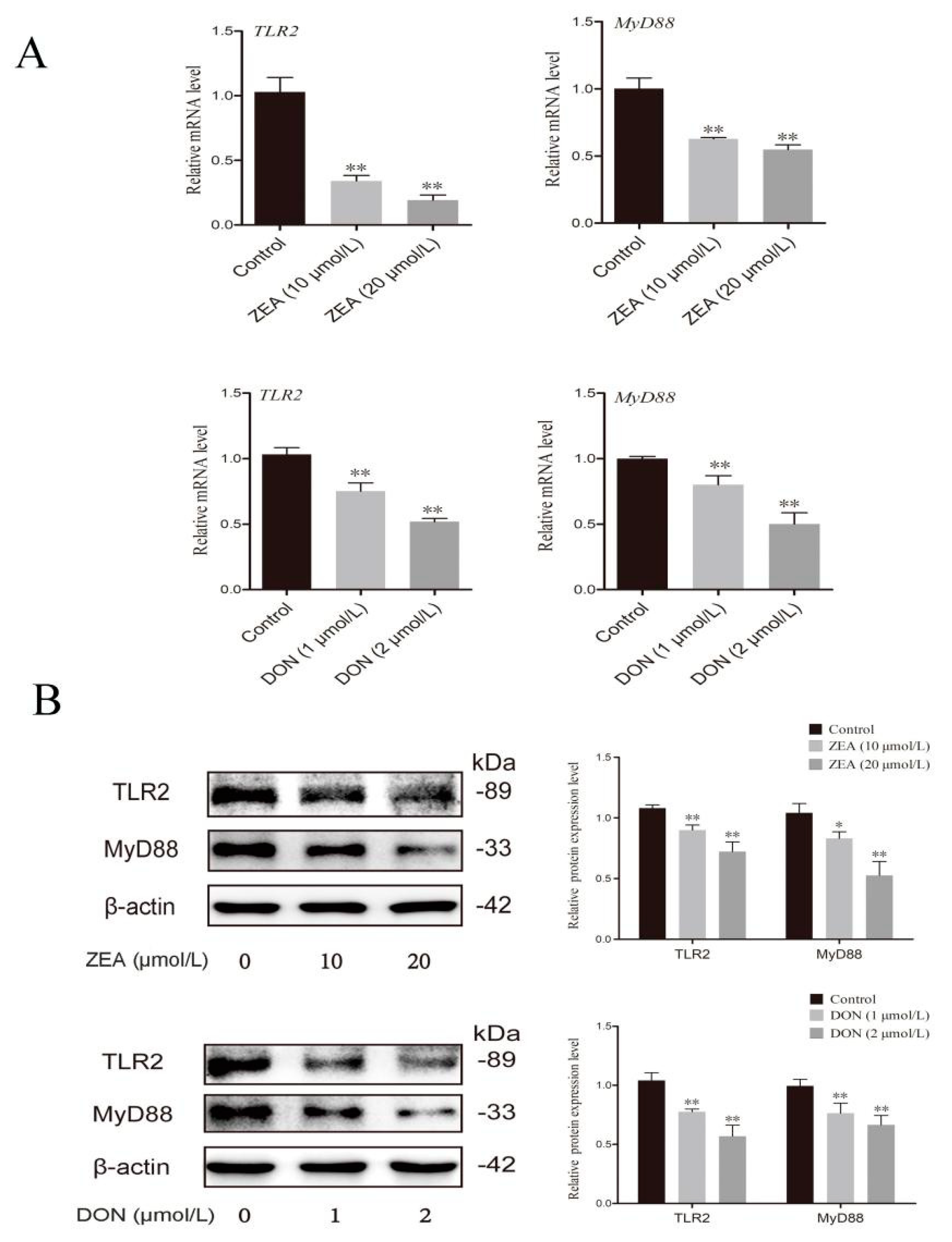
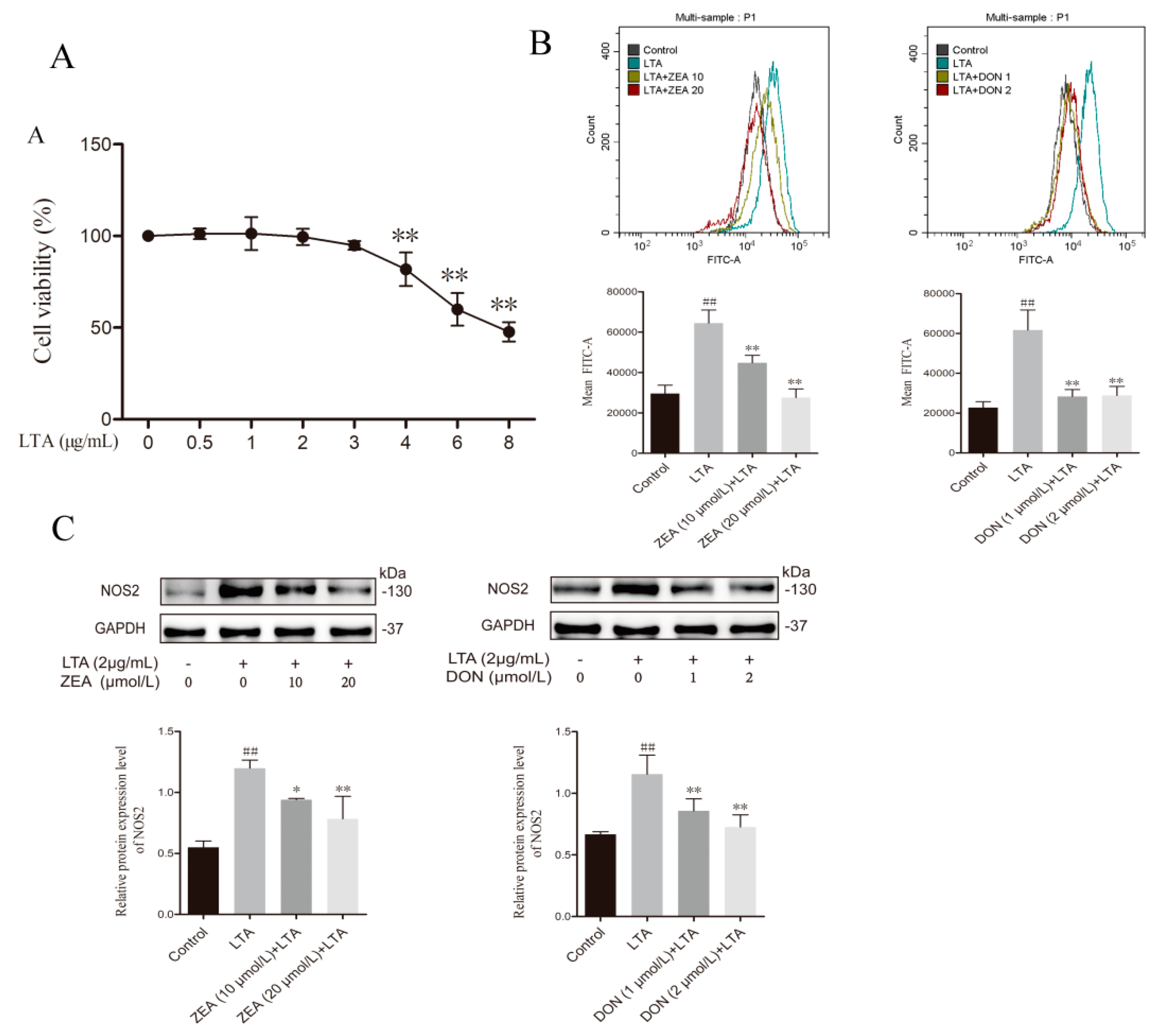

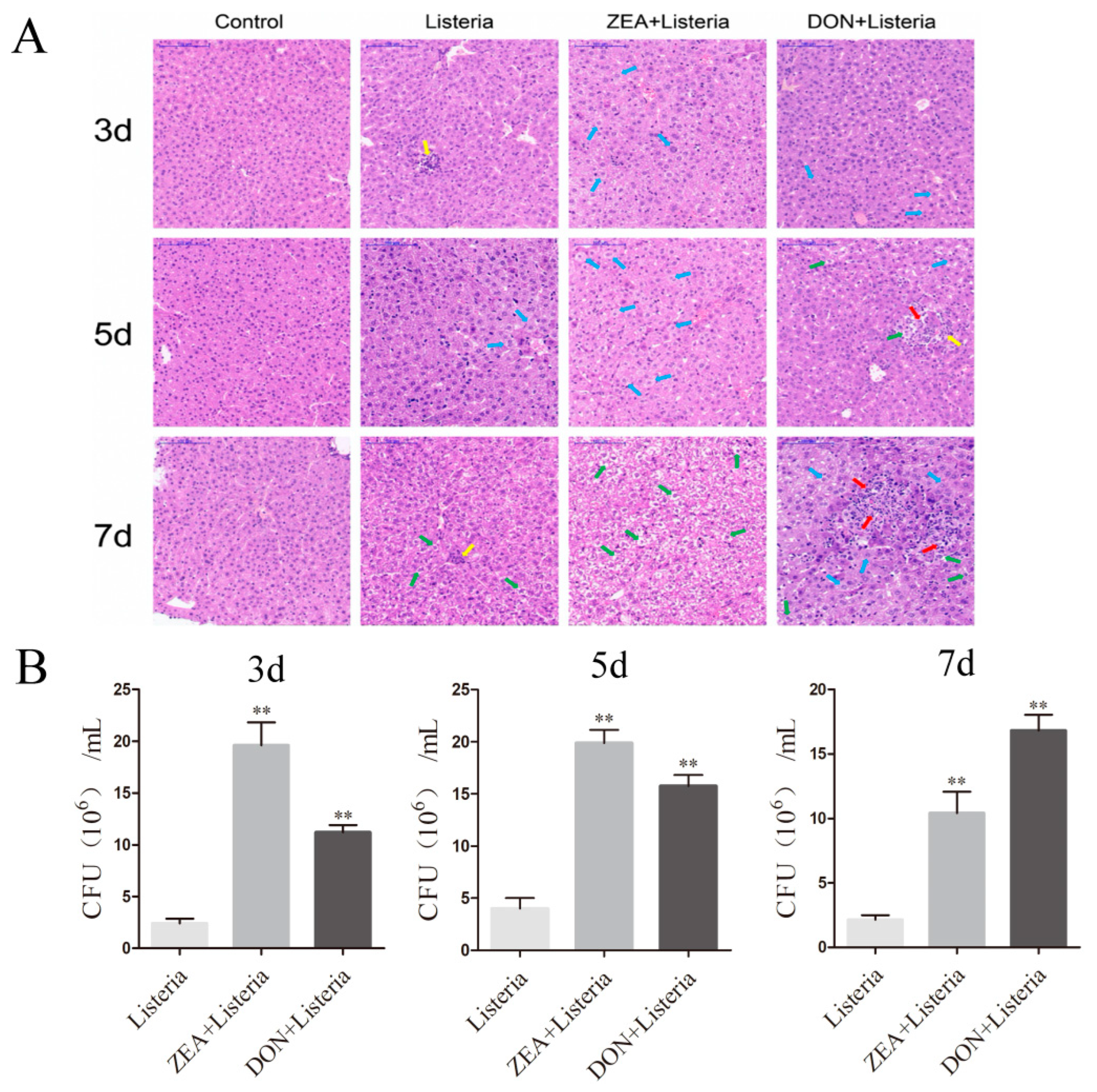
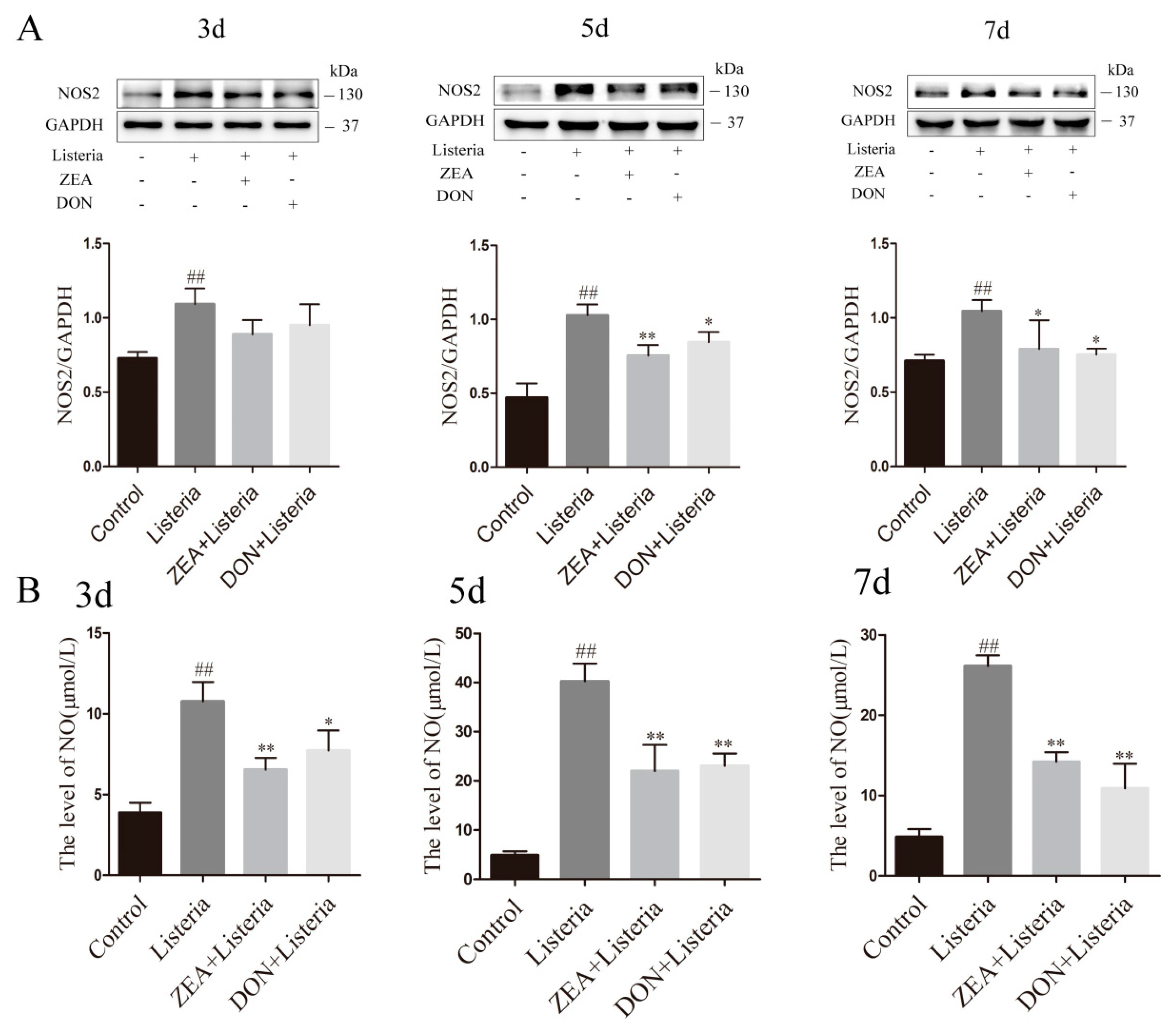

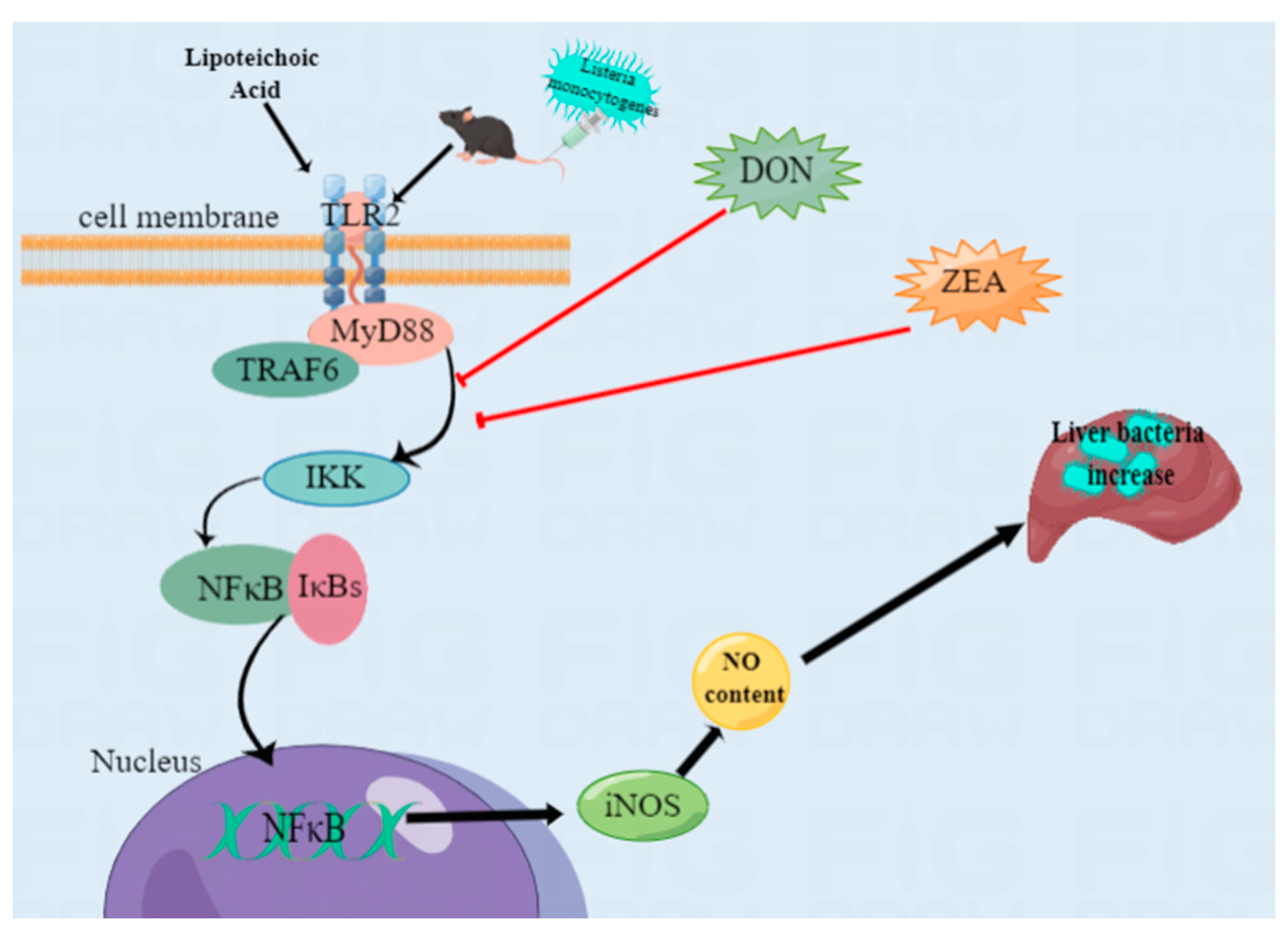
| Gene Name | Sequence (5′—3′) |
|---|---|
| TLR2 | F: TCTGGAGTCTGCTGTGCCCTTC |
| R: GGAGCCACGCCCACATCATTC | |
| MyD88 | F: ATACGCAACCAGCAGAAACAGGAG |
| R: GGTGATGCCTCCCAGTTCCTTTG | |
| GAPDH | F: CCTTCATTGACCTCAACTACATG |
| R: CTTCTCCATGGTGGTGAAGAC |
| Gene Name | Sequence (5′—3′) |
|---|---|
| TLR2 | F: CTCCCAGATGCTTCGTTGTTCCC R: GTTGTCGCCTGCTTCCAGAGTC |
| MyD88 | F: AGCAGAACCAGGAGTCCGAGAAG |
| R: GGGCAGTAGCAGATAAAGGCATCG | |
| GAPDH | F: TCAAGAAGGTGGTGAAGCAG |
| R: AGTGGGAGTTGCTGTTGAAGT |
Disclaimer/Publisher’s Note: The statements, opinions and data contained in all publications are solely those of the individual author(s) and contributor(s) and not of MDPI and/or the editor(s). MDPI and/or the editor(s) disclaim responsibility for any injury to people or property resulting from any ideas, methods, instructions or products referred to in the content. |
© 2023 by the authors. Licensee MDPI, Basel, Switzerland. This article is an open access article distributed under the terms and conditions of the Creative Commons Attribution (CC BY) license (https://creativecommons.org/licenses/by/4.0/).
Share and Cite
Feng, N.; Zhong, F.; Cai, G.; Zheng, W.; Zou, H.; Gu, J.; Yuan, Y.; Zhu, G.; Liu, Z.; Bian, J. Fusarium Mycotoxins Zearalenone and Deoxynivalenol Reduce Hepatocyte Innate Immune Response after the Listeria monocytogenes Infection by Inhibiting the TLR2/NFκB Signaling Pathway. Int. J. Mol. Sci. 2023, 24, 9664. https://doi.org/10.3390/ijms24119664
Feng N, Zhong F, Cai G, Zheng W, Zou H, Gu J, Yuan Y, Zhu G, Liu Z, Bian J. Fusarium Mycotoxins Zearalenone and Deoxynivalenol Reduce Hepatocyte Innate Immune Response after the Listeria monocytogenes Infection by Inhibiting the TLR2/NFκB Signaling Pathway. International Journal of Molecular Sciences. 2023; 24(11):9664. https://doi.org/10.3390/ijms24119664
Chicago/Turabian StyleFeng, Nannan, Fang Zhong, Guodong Cai, Wanglong Zheng, Hui Zou, Jianhong Gu, Yan Yuan, Guoqiang Zhu, Zongping Liu, and Jianchun Bian. 2023. "Fusarium Mycotoxins Zearalenone and Deoxynivalenol Reduce Hepatocyte Innate Immune Response after the Listeria monocytogenes Infection by Inhibiting the TLR2/NFκB Signaling Pathway" International Journal of Molecular Sciences 24, no. 11: 9664. https://doi.org/10.3390/ijms24119664





